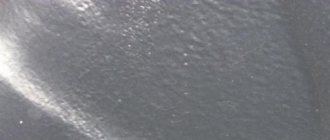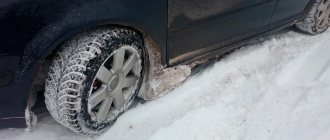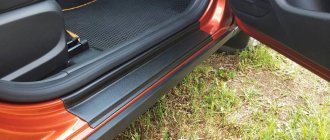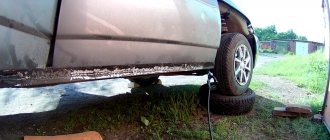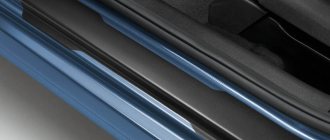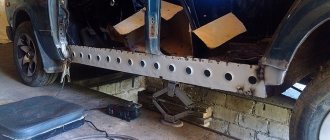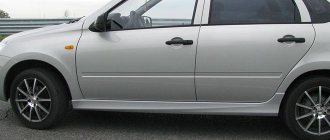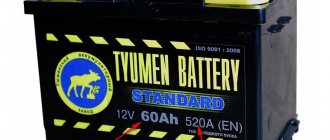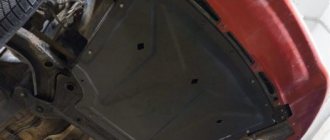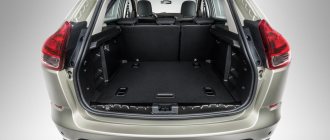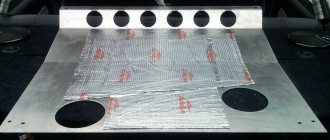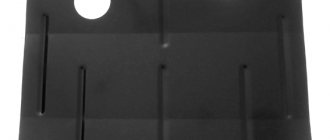Car thresholds (boxes) are one of the most problematic body elements after wheel arches. As a rule, arches, sills, and door edges are often damaged and are most susceptible to corrosion.
To protect thresholds, the following procedures must be carried out:
- internal threshold processing;
- external threshold protection.
Please note that these operations are carried out comprehensively. Internal treatment should be carried out to protect internal (hidden cavities) from moisture. External treatment involves protecting the paintwork of the threshold from chips and other damage in order to avoid the onset of active corrosion. Read more in our article.
Why do you need to additionally process thresholds?
Modern cars usually have minimal sill protection when leaving the factory. At the same time, thresholds for cars are often treated at the factory with “anti-gravel”, which is painted on top in the color of the body. Less often, some models additionally receive plastic door sills, etc.
It is important to understand that regardless of the type and quality of protection, during vehicle operation, thresholds require special attention for the following reasons:
- when getting in and out of a car, the threshold is often caught by shoes, damaging the paintwork;
- stones and sandblasting cause paint chips and deep scratches on the thresholds;
- collisions with obstacles, high curbs, errors when working with a lift or jack often lead to jamming of the thresholds;
- the adhesion of snow and ice mixed with salt and chemical reagents leads to active corrosion;
- insufficient ventilation of the thresholds leads to hidden internal corrosion of the closed box;
In all cases, the main problem is unprotected metal, which quickly begins to rust in winter. For these reasons, it is necessary to protect the thresholds from corrosion. Otherwise, you will need to replace the threshold, which is much more expensive than protecting the boxes.
List of materials
Here we answer the question of how to paint car sills to protect them from corrosion. The easiest option is to apply a protective composition without painting it. The result will look like below:
Anti-gravel protection without painting
The anti-gravel layer itself can be varnished. This is done to get a glossy surface. By the way, many anti-gravel compounds do not allow the use of varnish and paints - after application, a film is formed that has elasticity. In general, you need to have an exact idea of what exactly should happen in the finale.
The finished layer of anti-gravel coating, if it was applied several days ago, cannot be varnished - it is better to leave everything as is, or paint it.
Before applying anti-gravel, the surface must be degreased. For this, solvents that do not contain acetone are used. Use solvent. You will also need P400-P1000 sanding paper. It is used for matting.
There is widespread advice that any anti-gravel needs to be varnished. Perhaps for some materials this is 100% true. However, the choice remains with the owner. You can choose a material that does not require additional protection.
How to treat thresholds from the inside
To protect car sills from corrosion inside the boxes, you need to perform anti-corrosion treatment. In this case, you can use both ready-made anti-corrosion compounds (for example, Rust-Stop for hidden cavities), and the well-known Movil in thresholds or other solutions.
At the same time, experts recommend using professional solutions, since they tend not to dry out, have good fluidity and covering power of surfaces, contain special corrosion inhibitors, etc.
The main task comes down to effectively spraying a protective agent inside the box, which will then protect the metal (often untreated) and displace moisture. The treatment can be done through special technological holes, which are made in the car boxes for ventilation (can be hidden behind mudguards and fender liners).
What do you need to have to process thresholds yourself?
For anti-corrosion treatment of thresholds you will need:
- anti-corrosion composition;
- rust modifier;
- wire brush and abrasive;
- water;
- degreaser;
- rags;
- masking tape;
- protective equipment due to the toxicity of fumes (gloves, respirator, clothing that completely covers the skin, goggles).
Before starting work, be sure to read the instructions and fulfill all requirements. If it is not possible to carry out work in a warm garage or box, move it to the summer. In winter and autumn, such treatment is carried out in a warm room. Be sure to wash and dry the car before the procedure.
Anti-corrosion treatment of the threshold
External protection of car thresholds
In addition to internal protection, thresholds must be treated externally. For these purposes, you can use various means. As a rule, these are the following compositions:
- anti-gravel for thresholds;
- special mastic;
- anti-corrosion agents.
Such coatings can be purchased in aerosol cans; there are also “brush” or “gun” solutions. The protection is applied from above, that is, directly onto the primer, paint or varnish.
- The easiest and fastest way is to apply a ready-made anti-corrosion agent to the thresholds without painting or any additional processing.
- A more complex method is anti-gravel treatment, which can be combined with subsequent coating with paint or varnish to obtain a gloss effect (the main thing is to choose compositions that can be treated with paint or varnish);
- To obtain a durable and thick protective layer, it is optimal to use the method of treatment with anti-corrosion mastic. In this case, the surface will need to be prepared in advance so that the protective coating adheres well to the thresholds.
Another option is a protective anti-gravel armor film on the car, which is glued to the threshold after it has been treated with a suitable composition or painted. This method is especially in demand if you had to buy a threshold and install it on a car, paint the thresholds, after which protection is also required while completely preserving the appearance of the freshly painted element.
Nuances of choosing purchased processing products
When choosing anti-corrosion body protection products, the characteristics of the product are strictly checked: purpose, shelf life, interaction with auxiliary materials, indications for application. The product is supplied in cans or metal cans, depending on the composition and method of application to the cavities of the car.
The chemical composition of both expensive and more economical anticorrosive agents is aggressive and dangerous to the human body. Therefore, the use of rubber gloves and closed clothing is mandatory.
The range of corrosion inhibitors is very wide. They differ in application methods, composition components, environmental resistance, drying time, and price indicators. Alternative options for anti-gravel are:
- Used technical oil. Used in older car models. It has a strong unpleasant odor and low environmental friendliness.
- Movil. Anti-corrosion inhibitor of liquid structure. Named after two cities (Moscow and Vilnius). Created in the middle of the last century as the main means of overcoming rust in car components. The composition includes oils, kerosene, drying oil and a small percentage of specific additives.
- Special mastics based on rubber. The composition contains certain types of resins. They are distinguished by increased viscosity, labor-intensive application process, and increased temperature requirements for use.
How to process thresholds with your own hands
For independent external treatment of thresholds, it is better to choose a simple method with anti-gravel in an aerosol can. Before treatment, you must wash the car and dry the car. It is better to carry out all work on a lift or overpass.
You should also prepare tools and materials:
- metal cleaning brush;
- sandpaper with “fine” and “medium” grain;
- anti-gravel;
- degreaser (White Spirit will do);
- rust converter;
- construction hair dryer;
- masking tape;
- container with clean water and rags.
Preparation of thresholds
First, use sandpaper to remove rust from the metal on the thresholds. Next, all areas will need to be treated with a rust converter and dried.
Then all areas that will not be treated are covered with masking tape. At this point, preparation for processing is completed and you can proceed to applying the protective composition.
We also recommend reading the article about how to treat the underbody of a car to protect against corrosion. From this article you will learn about the available methods for treating the bottom to protect against rust.
Application of anti-gravel
- Before spraying, shake the aerosol can well for a couple of minutes;
- It is necessary to spray the product onto the threshold from a distance of about 20 cm;
- It is necessary to spray so that the composition lies evenly on the surface;
- After applying the first layer, you must wait about 10 minutes;
- To form the coating, it is necessary to apply at least 3 layers;
- After finishing the treatment, the anti-gravel is dried with a hair dryer.
Once the drying phase is complete, the masking tape can be removed. It is not recommended to operate the car immediately after treatment. It is necessary to wait about 2-3 hours for the protective material on the thresholds to dry completely.
Let us also add that if mastic was used instead of anti-gravel, which is applied with a brush, such material cannot be dried with a hairdryer. The mastic on the thresholds should dry on its own. Typically the drying process ranges from 2-3 to 10-12 hours.
The reverse light is constantly on: the main reason, how to fix it
- dismantling protection;
- washing the car and especially the thresholds;
- thoroughly dry the machine;
- installing a car on an overpass or lift;
- removing all existing traces of corrosion with sandpaper or a polishing disc;
- applying a rust converter;
- degreasing;
- re-drying;
- covering with masking tape areas that are located near the thresholds, but will not be treated.
Preparation is of great importance for the final result of the anti-corrosion treatment. It is especially important to get rid of any existing rust and any drops of water. A hair dryer or some kind of heater, for example, will help here.
Anti-gravel treatment
And now the final stage. No less responsible and important. The complexity of application largely depends on the form of release you buy. Spray cans are more expensive, but much more convenient and effective at an excellent level.
The essence of the procedure is as follows:
Recommendations
- It should be taken into account that it is quite difficult to buy a high-quality threshold for a car if a replacement is necessary. For this reason, it is better to take care of the body and individual elements than to carry out expensive body work and replacement of thresholds. It should be remembered that without treatment and protection, the sills, even on a new car with minor damage, can rot within 4-5 years.
- If any repairs to the thresholds were carried out (installation of patches, welding, pulling), the repair site must be additionally processed both outside and inside.
Otherwise, the repair areas will be subject to corrosion after a short period of time. We also recommend reading the article on how to remove rust from a car body. From this article you will learn about available ways to remove rust from a car body with your own hands. - During the operation of the car, it is necessary to periodically remove the mudguards and linings to clean out dirt, debris, leaves, sand particles in the sill area, etc. This will protect against premature corrosion in these places and will normalize the ventilation of the box.
- To prevent snow and ice from sticking to the sills and fender liners in winter, these elements can be treated with compounds such as WD-40. The formed greasy film repels moisture and snow, preventing the formation of ice in the fender liners and in the area of the mudguards. Also, the lower part of the threshold can be treated with silicone grease.
Treatment of hidden threshold cavities should be performed at least once every 2-3 years. At the same time, the old “old-fashioned” methods like pouring “working out” into the thresholds, Moville with cannon fat, etc. may be less effective than using modern solutions.
It is better to treat the thresholds from the inside with special compounds with corrosion inhibitors, which, after application, spread most effectively over the entire surface of the box and protect the metal of the box.
Through external openings
Anti-corrosion treatment of hidden cavities can be carried out using Movil with zinc, which is offered in the form of a spray in a can with a tube, as well as a similar product with bronze additives in a bottle. You will also need a syringe with a capacity of 30 cubes with a tube instead of a standard needle, and a brush for painting.
Before starting processing, you need to prepare the threshold by dismantling the inner and outer trim, and place the product in the sun to heat up.
Next, carry out processing in the following sequence:
- Remove the plugs on the side of the sill using a screwdriver.
- Insert the balloon tube further into the holes formed, blow the contents inside, turning the tube in different directions. In this case, at least two layers should be formed.
- At the next stage, thoroughly shake the bottle with Movil. Open the lid and draw up the composition using a syringe. Insert the contents into the internal cavity of the threshold. Do the same procedure for all holes.
- Then use a brush to coat the outside of the thresholds with the same product. After drying, bronze particles remain on top.
The last step is to install the plugs in place. Thus, processing the threshold with this method does not require any serious time or physical investment.
Processing process
- If you decide to process the body yourself, then before you start processing, you need to clean the elements being processed from dirt and other unnecessary elements. If the body is properly cleaned before treatment, the product can last much longer than its service life. In order for everything to last for a long time, after washing you need to dry the body parts.
- After the body has been dried, it would be advisable to degrease it. This will further increase the shelf life of the coating.
- After the preparation has been carried out, you can begin to apply a layer of anti-corrosion agent. In order to apply a layer of this substance to closed elements, you will need a sprayer. The most common type of sprayer used is a paint sprayer. The product for hidden elements is often sold in cans, which further simplifies the procedure. If the product will be applied to the arches and bottom, then you need to take a brush or roller.
It must be applied in several layers, each of which must be dried. Some products need to be applied not to bare metal, but to metal that is already coated with primer. Most often this is indicated on the packaging of such products. Therefore, you need to read the instructions before applying the substance to your car.
Method 2 car wash to prevent corrosion
- Wash your car regularly. While dirt is often not corrosive, sediment and impurities can bleed through the paint, damaging the body over time. Bird droppings and gasoline spilled while refueling can reduce your vehicle's rust resistance even further. Over time, they damage the coating and make it more susceptible to corrosion. Wash your car every few weeks to prevent sand and dirt from damaging the paint.
- Wash the car chassis. If you live in a snowy region, salt and chemical deposits on the underside of the machine can compromise its ability to resist corrosion. Please note that many automatic car washes offer chassis cleaning. You can also jack up your car and wash the underbody with a hose.
- Use baking soda to neutralize road salt. If you often encounter this problem, you should add some baking soda and soap to the water. A tablespoon of baking soda will neutralize the acidic effect of salt and other chemicals used on the roads. Be sure to mix the above product with soap and you will immediately notice positive results. One tablespoon of baking soda is enough to clean the undercarriage of most cars.
- Wash the car thoroughly. Leaving dried soap on your vehicle can also shorten the life of the paint. Make sure you rinse all the soap off your car every time you clean it. Never wash it in direct sunlight, as this can cause the chemicals in the detergent to dry before the paint itself. You can apply the soap to certain areas of your vehicle and then rinse it off with strong water pressure.
- Your car's finish needs to be waxed. This should be done at least twice a year. Wax provides your car with a beautiful shine and also protects the paint from color loss and damage. Using this product at least twice a year will provide the body with an additional layer of protection and will help reduce the likelihood of rust formation. The wax repels water and creates another additional protective layer for the body.
Threshold straightening
ZF center Blog Automatic transmission repair Renault Duster
In case of minor damage to the thresholds, it makes sense to carry out minor straightening repairs. But if, in addition to a violation of the geometry of the body or the integrity of the paintwork, deeply damaged or rotten sections of metal are found, then it is more advisable to purchase a new part. Usually the threshold forms a single unit with the body, giving it additional rigidity, but there are also removable thresholds.
Removable threshold
The car's removable threshold is usually located on the outer side of the side member. It protects the body from small stones that jump out from under the wheels.
Straightening the threshold with a spotter
Straightening and subsequent painting of removable car sills is much easier than in the case of a non-removable part. To do this, you must first dismantle it by unscrewing the screws with which it is attached to the spar. Then the dents are straightened, the inside is treated with anti-corrosion primer or ointment, preparation for painting and painting. After re-installing the threshold, areas damaged during installation are repainted.
Fixed threshold
When straightening such parts, the dents are pulled outward. To do this, the old layer of paint is removed, and special extraction hooks are welded to the damaged area. They are grabbed with a special inertial puller (spotter) and the dent is leveled.
In addition, you can cut out the damaged area and replace it with a new one, leveling the surface with subsequent putty and painting. When the straightening is completed, we move on to the preparatory stage before painting the threshold.
https://youtube.com/watch?v=50hc0VsBYvQ
